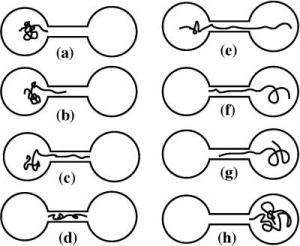Jul 15 2010
The movement of long chain polymers through nanopores is a key part of many biological processes, including the transport of RNA, DNA, and proteins. New research reported in The Journal of Chemical Physics, which is published by the American Institute of Physics, describes an improved theoretical model for this type of motion.
 This shows the typical configurations of polymer translocation through nanopores.
This shows the typical configurations of polymer translocation through nanopores.
The new model addresses both cylindrical pores and tapering pores that simulate the á–hemolysin membrane channel. "Current models do not take into account the motion of the polymer inside the pore," says author Anatoly Kolomeisky of Rice University. "The leading monomer can move back and forth many times before it finally crosses the line to the other side of the membrane. Not accounting for this behavior introduces errors into predictions."
By improving the boundary conditions for polymer movement inside the pore, researchers demonstrated a significant increase in total time in the pore compared to earlier models. In modeling a tapering pore, they confirmed that translocation occurs faster when the polymer enters the wide side of the pore.
Possible technological applications include advances in DNA sequencing and the development of biosensors using membranes. "To design an effective sensor, it is essential to understand what you are observing and how the molecule reaches the detector," says Kolomeisky.
Source: http://www.aip.org/